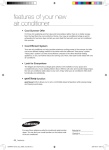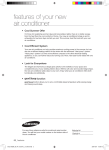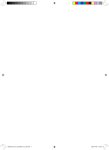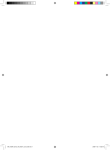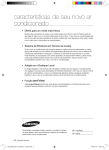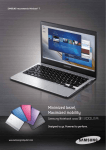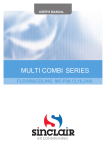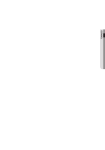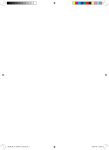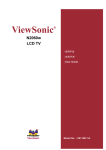Download Samsung AQ09UGDN Uživatelská přiručka
Transcript
Vivaldi_IM_30271A_E_11.07.09.indd 1 2009-11-7 13:55:40 Contents SAFETY PRECAUTIONS . . . . . . . . . . . . . . . . . . . . . . . . . . . . . . . . . . . . . . . . . . . . . . . . . . 3 PREPARING FOR INSTALLATION Choosing the Installation Location . . . . . . . . . . . . . . . . . . . . . . . . . . . . . . . . . . 5 Accessories . . . . . . . . . . . . . . . . . . . . . . . . . . . . . . . . . . . . . . . . . . . . . . . . . . . . . . . . . 8 INSTALLING THE AIR CONDITIONER Fixing the Installation Plate . . . . . . . . . . . . . . . . . . . . . . . . . . . . . . . . . . . . . . . . . Connecting the Assembly Cable . . . . . . . . . . . . . . . . . . . . . . . . . . . . . . . . . . . Installing and Connecting the Assembly Pipe of the Indoor Unit . . . Purging the Indoor Unit . . . . . . . . . . . . . . . . . . . . . . . . . . . . . . . . . . . . . . . . . . . Cutting or Extending the Pipe . . . . . . . . . . . . . . . . . . . . . . . . . . . . . . . . . . . . . . Installing and Connecting the Drain Hose of the Indoor Unit . . . . . . Changing Direction of the Drain Hose . . . . . . . . . . . . . . . . . . . . . . . . . . . . . . Installing and Connecting the Drain Hose of the Outdoor Unit . . . . . 9 10 12 13 14 15 16 17 COMPLETING THE INSTALLATION Purging the Connected Pipes . . . . . . . . . . . . . . . . . . . . . . . . . . . . . . . . . . . . . . . Performing the Gas Leak Tests . . . . . . . . . . . . . . . . . . . . . . . . . . . . . . . . . . . . . . Fixing the Indoor Unit in Place . . . . . . . . . . . . . . . . . . . . . . . . . . . . . . . . . . . . . . Fixing the Outdoor Unit in Place . . . . . . . . . . . . . . . . . . . . . . . . . . . . . . . . . . . . Final Check and Trial Operation . . . . . . . . . . . . . . . . . . . . . . . . . . . . . . . . . . . . . Providing Information for User . . . . . . . . . . . . . . . . . . . . . . . . . . . . . . . . . . . . . . Pump Down Procedure (When removing the product) . . . . . . . . . . . . . 18 20 21 21 22 23 23 In this manual, you may find model names written in simplified forms as indicated in following table. Model Names Included Models Remark AQ09E, AQ12E, AQ18E, AQ24E Grouping AQR AQ09R was done by series. AQ09U, AQ12U, AQU AQ18U, AQ24U AQ09E, AQ09R, 09 AQ09U Grouping 12 AQ12E, AQ12U was done by capacity. 18 AQ18E, AQ18U 24 AQ24E, AQ24U AQE Simplfied model names were used in pages 5, 8, 9, 10, 11, 18, 20. E-2 Vivaldi_IM_30271A_E_11.07.09.indd 2 2009-11-7 13:55:40 ENGLISH Safety Precautions Keep this installation manual together with the user’s manual in a handy place so that you can find it whenever you need to see it after reading this manual thoroughly. Make sure you read this ‘Safety Precautions’ carefully before installing the product. Safety Precautions states information that is important to your safety matters. Please follow the instructions carefully. WARNING Hazards or unsafe practices that may result in severe personal injury or death. CAUTION Hazards or unsafe practices that may result in minor personal injury or property damage. You must install the product by qualified installer. If you install the product on your own or by unqualified person, Samsung is not responsible for any damages which may occur due to incorrect installation. Make sure to read the following safety precautions carefully before installation. Make sure to observe the cautions specified in this manual. Conduct a test run of the unit after installation and then explain all system functions to the owner. The indications and meanings are as shown below. Follow IEC (International Electrotechnical Commission) standards for the power input and ISO (International Standards Organization) standards for input current. WARNING Hazards or unsafe practices that may result in severe personal injury or death. Installation must be carried out by a qualified installer. Do not attempt to repair, move, modify or reinstall the unit on your own since such act may cause fire, electric shock or water leakage. Install the unit in a place where it is strong enough to hold the product weight. When installed in place where it is not strong enough to withhold the product weight, the unit could fall and cause injury. The unit should be installed in accordance with the National Electrical regulations. Check if the voltage and the frequency of the main power supply are those required for the unit to be installed and check the connection. Avoid the use of an extension cord and do not share the power outlet with other appliances. Incomplete connection, defective insulation or exceeding the permissible current may cause electric shock or fire. Use the specified wires to connect the indoor and outdoor units securely and attach the wires firmly to the terminal block connecting sections so that the pressure is not applied to the sections. Inappropriate connection and fixing could cause fire. Attach the electrical cover to the indoor and outdoor unit securely without any gaps. If there are any gaps, there is potential risk of fire or electric shock due to dust or water. Make sure to use the part provided or specified parts for the installation work. The use of defective parts could cause an injury or leakage of water due to a fire, an electric shock, the unit falling, etc. Make sure that the refrigerant gas does not leak after completing the installation. If the refrigerant gas of the indoor unit leaks and comes into contact with the fan heater, space heater or stove, harmful gas will be generated. Ensure that the national safety code requirements have been followed for the main supply circuit. Ensure that a proper ground wire is in place. Do not connect the ground to a gas pipe, water pipe, lightning rod or telephone grounding. Defective grounding could cause electric shock. Do not install the unit in a place with direct sunlight, dangerous substances or where it is exposed to inflammable gas leakage to prevent explosion, fire or personal injury. Perform the installation securely referring to the installation manual. Incomplete installation could cause personal injury due to fire, electric shock and water leakage or from the unit falling. Before connecting the power plug and power receptacle check for dust, loose or blocked. Make sure that plug is fully inserted. Dusted power plug, blocked or loosened power receptacle may cause fire or electric shock. Exchange the power receptacle if it is loose. Check first the following situations before starting the operation during the installation. - The pipe must be properly connected and make sure there is no leakage. - Service valves must be open. If compressor is operated with the service valve closed, excessive pressure may damage parts of the compressor. If leakage occurs on any of the connection, air inflow may also cause excessive pressure that could lead to explosion. E-3 Vivaldi_IM_30271A_E_11.07.09.indd 3 2009-11-7 13:55:40 Safety Precautions (Continued) WARNING Hazards or unsafe practices that may result in severe personal injury or death. Stop the compressor before disconnecting the refrigerant pipe for pump-down operation. If you disconnect the refrigerant pipe while compressor is operating with service valve open, air inflow will cause excessive pressure in the refrigerant cycle that could lead to explosion and personal injury. Do not assemble the power cord on your own, use two cables together to extend the cable length or tangle the cable. Bad connection, isolation and over voltage may cause fire or electric shock. CAUTION work securely according to the installation manual. If not, water could drop from the unit and household goods could get wet and damaged. Fasten a flare nut with a torque wrench as specified in this installation manual. When fastened too tight, a flare nut may break after a long period of time and cause refrigerant leakage. Wear thick gloves during the installation process. If not, personal injury may occur due to the air conditioner parts. Be careful not to touch the outdoor unit inlet or aluminium pins. You may get personal injury. The air conditioner should be used only for the applications for which it has been designed: the indoor unit is not suitable to be installed in areas used for laundry. When installing the indoor unit, use a stable stool and watch your steps carefully. To prevent injury when Vivaldi_IM_30271A_E_11.07.09.indd 4 main power when setting up the indoor unit electrical circuit or power cords. There is a risk of electric shock. Make sure that proper circuit breaker and safety switches are installed. Install a ground leakage breaker depending on the installation place(where it is humid). If not, it may cause electric shock. Do not install the unit by yourself (owners). Incorrect installation of the unit could cause injury due to fire, electric shock and water leakage or from the unit falling. Consult a dealer or a qualified installer. Use the unit on a single outlet circuit. Do not share the power outlet with other appliances. Obtain the consent by a qualified installer before connecting the unit to the power supply system. Hazards or unsafe practices that may result in minor personal injury or property damage. Perform the drainage/piping E-4 Make sure to turn off the accidentally touching the indoor unit fan, install the indoor unit at least 2.5m above the floor level. Our units must be installed in compliance with the spaces indicated in the installation manual to ensure either accessibility from both sides or ability to perform routine maintenance and repairs. The units’ components must be accessible and that can be disassembled in conditions of complete safety either for people or things. For this reason, where it is not observed as indicated into the Installation Manual, the cost necessary to reach and repair the unit (in safety, as required by current regulations in force) with slings, trucks, scaffolding or any other means of elevation won’t be considered in-warranty and charged to end user. Do not install the outdoor unit in a place where animals could live. If an animal get contact with the electric parts, damage or fire may occur. In addition ask the customer to maintain a clean installation place around it. After completing the installation run the trial operation. If no error occurs, explain to the customer how to use and clean the air conditioner according to the user’s manual. In addition give the installation manual and the user’s manual to the customer. All of the manufacturing and packaging material used for your new appliance are compatible with the environment and can be recycled. Dispose of the packaging material in accordance with the local requirements. This product is an air conditioning system and contains a coolant that must be recovered and disposed of in an appropriate way by qualified personnel. At the end of the life cycle, take it to a proper recycling or disposal center or return it to the dealer so that it can be disposed correctly. Check the unit for damage that may have taken place during transportation and do not install or use damaged equipment. 2009-11-7 13:55:41 PREPARING FOR INSTALLATION Indoor Unit Outdoor Unit Where airflow is not blocked Where cool air can be distributed throughout the room Install the refrigerant piping length and the height difference of both indoor and outdoor units as indicated in the installation diagram Wall that prevents vibration and is strong enough to hold the product weight Out of the direct sunlight 1m or more away from the TV or radio (to prevent the screen from being distorted or noise from being generated) As far away as possible from the fluorescent and incandescent lights (so that the remote control can be operated well) A place where the air filter can be replaced easily Where it is not exposed to strong wind Well ventilated and dustless places Out of the direct sunlight and rain Where neighbors are not annoyed by operation sound or hot air Solid wall or support that prevents vibration and is strong enough to hold the product weight Where there is no risk of flammable gas leakage When installing the unit at a high place be sure to fix the unit legs 3m or more away from the TV or radio (to prevent the screen from being distorted or noise from being generated) Install the unit horizontally Place where drained water does not become any problem. Place with no plants (especially climbing plants) and where small animal can not access. ENGLISH Choosing the Installation Location CAUTION Avoid the following places to prevent malfunction of the unit - Where there is machine oil - Where sulfide gas exists - Salty environment such as seaside areas - Other special atmosphere areas Observe the clearances and maximum lengths as seen in the picture below when installing the air conditioner. 300mm or more 125mm or more Wrap the refrigerant pipes and the drain hose with the absorbent pad and vinyl tape. Refer to page 19 for further details. 125mm or more You can select the direction of draining (left or right). CAUTION: 'L' m as maximum pipe length and 3 m as minimum pipe length (It will reduce noise and vibration) 600mm minimum ' L ' meters maximum total pipe length 300mm minimum 300mm minimum 600mm minimum ' H ' meters maximum total pipe length Model 09 12 18 24 L 15 15 15 20 H 7 7 7 8 Make at least one round: It will reduce noise and vibration The appearance of the unit may be different from the diagram depending on the model. Vivaldi_IM_30271A_E_11.07.09.indd 5 E-5 2009-11-7 13:55:43 PREPARING FOR INSTALLATION Choosing the Installation Location (Continued) Space Requirements for Outdoor Unit When installing 1 outdoor unit Unit : mm When the air outlet is towards the wall 1500 or more 300 or more When the air outlet is opposite the wall When 3 sides of the outdoor unit are The upper part of the outdoor unit and 2000 or more 600 or more 150 or more The upper part of the outdoor unit and When the walls are blocking front and the rear side of the outdoor unit 1500 or more 300 or more the air outlet is opposite the wall 500 or more 1500 or more the air outlet is towards the wall 300 or more blocked by the wall 300 or more Figure Description Top view Side view Air intake Air outlet Air intake Air outlet , Air flow direction. CAUTION E-6 Vivaldi_IM_30271A_E_11.07.09.indd 6 If installation is done in inappropriate space, unit may generate sound and cause bad effect on the product. Installation must be done in level and in a place where vibration will not cause any effect. 2009-11-7 13:55:53 ENGLISH PREPARING FOR INSTALLATION When installing more than 1 outdoor unit Unit : mm 1500 or more When the air outlet is towards the wall 300 or more When 3 sides of the outdoor unit are blocked by the wall 300 or more 600 or more 600 or more 600 or more When the walls are blocking front and the rear side of the outdoor units 500 or more 600 or more and the air outlet is opposite the wall 1500 or more 300 or more 600 or more 600 or more 3000 or more 3000 or more 500 or more When front and rear side of the outdoor unit is towards the wall 1500 or more When the upper part of the outdoor unit 300 or more 300 or more 200 or more CAUTION If installation is done in inappropriate space, unit may generate sound and cause bad effect on the product. Installation must be done in level and in a place where vibration will not cause any effect. E-7 Vivaldi_IM_30271A_E_11.07.09.indd 7 2009-11-7 13:55:53 PREPARING FOR INSTALLATION Accessories The following accessories are supplied with the air conditioner: The number of each accessory is indicated in parentheses. Note Accessories in the Indoor Unit Case Installation Plate (1) Remote Control (1) AQR/U Remote Control (1) AQE Batteries for Remote Control (2) User’s Manual (1) Installation Manual (1) Accessories in the Outdoor Unit Case 5-wire Assembly Cable (1) Drain Plug (1) Rubber Leg (4) 09/12/18/24 Note The flare nuts are attached to the end of each pipe of an evaporator or a service port. Use the nuts when connecting the pipes. The 5-wire assembly cable is optional. If it is not supplied, use the standard cable. The drain plug and rubber leg are only included when the air conditioner is supplied without the assembly pipe as seen in the picture below. The following connection accessories are optional. If they are not supplied, you should obtain them before installing the air conditioner. Insulated Insulated Insulated Insulated PE T3 Foam Tube Assembly Pipe, Assembly Pipe, Assembly Pipe, Assembly Pipe, Insulation (1) x 5m (1) Ø9.52mm x 5m (1) Ø12.70mm x 5m (1) Ø15.88mm Ø6.35mm x 5m (1) 09 12/18 24 Rubber Legs (4) Note Pipe Clamps A (3) Pipe Clamps B (3) Cement Nails (6) Ø4 x 25 Tapped Screws (6) Vinyl Tapes (2) Drain Plug (1) Drain Hose, length 2m (1) Putty 100g (1) If these accessories are supplied, they will be in the accessory box. Tools required for installation General Tools Vacuum Pump(Backward flowing prevention) Torque Wrench Pipe Cutter Spirit Level Screw Driver L Wrench Measuring Tape Manifold Gauge Reamer Spanner Stud Finder Pipe Bender Drill Tools for test operations Thermometer Resistance Meter Electroscope E-8 Vivaldi_IM_30271A_E_11.07.09.indd 8 2009-11-7 13:55:56 INSTALLING THE AIR CONDTIONER ENGLISH Fixing the Installation Plate You can select the direction of the drain hose depending on where you want to install the indoor unit. Therefore before fixing the installation plate to a wall or a window frame, you must determine the position of the 65mm hole through which the cable, pipe and hose pass to connect the indoor unit to the outdoor unit. Direction of pipe When facing the wall, the pipe and cable can be connected from the: Right (A) A Left (B) Underside_right (C) Rear_right or left (D) C Fix the indoor unit. (Unit : mm) Pipe hole (Ø65mm) 27 120 (Unit : mm) (1) Fix the installation plate to the wall giving attention to the weight of the indoor unit. Note If you mount the plate to a concrete wall using plastic anchors, make sure that gaps between the wall and the plate, created by projected anchor, is less than 20mm. 68 AQ18 Pipe hole (Ø65mm) 27 If you fix the indoor unit on a wall AQ12, AQ09E/U 27 Determine the position of the pipe and drain hose hole as seen in the picture and drill the hole with an inner diameter of 65mm so that it slants slightly downwards. CAUTION Make sure to drill only one hole after choosing the direction of the pipe. 2 D 27 1 B D 190 (Unit : mm) 68 AQ24 (1) Determine the positions of the wooden uprights to be attached to the window frame. (2) Attach the wooden uprights to the window frame giving attention to the weight of the indoor unit. (3) Attach the installation plate to the wooden upright using tapping screws. 140 (Unit : mm) 68 AQ09R Pipe hole (Ø65mm) 27 If you fix the indoor unit on a window frame 34 Wall 27 <20mm 34 Pipe hole (Ø65mm) Plastic Anchor 140 160 If you fix the indoor unit on a gypsum board (1) Use stud finder to find out locations of the studs. (2) Fix the plate hanger on two studs. CAUTION Search for other spots if there are less than two studs, or the distance between the studs are different from the plate hanger. CAUTION Fix the installation plate without incling to one side. WARNING Make sure that a wall can withstand the weight of the product. If you install the product in a place where it is not strong enough to withstand the product weight, the unit could fall and cause injury. E-9 Vivaldi_IM_30271A_E_11.07.09.indd 9 2009-11-7 13:56:17 INSTALLING THE AIR CONDTIONER Connecting the Assembly Cable Cable specification Model Power cable 09/12 3G, 1.0mm2 H07RN-F 18 3G, 1.5mm2 H07RN-F 24 3G, 2.5mm2 H07RN-F Interconnection cable 5G, 1.0mm2 H07RN-F 2G, 0.75mm2 3G, 1.5mm2 H07RN-F 3G, 2.5mm2 2G, 0.75mm2 H07RN-F Type GL 20A 25A Connect the power cable to the auxiliary circuit breaker. If every pole fails to connect to the power supply, it must be incorporated in a wire with a contact opening of ≥3mm. Note Connecting the cable When you install the unit, make first refrigerant connections and then electrical connections. Connect the air conditioner to grounding system before performing the electrical connection. If unit is uninstalled first disconnect electrical cables, then refrigerant connections. If the outdoor unit is more than 5 meters away from the indoor unit, you must extend the cable. The maximum length of the cable is 15(09/12)/100( 18/24) meters. 1 Extend the assembly cable if necessary. CAUTION Do not connect two or more different cables to extend the length. It may cause fire. 2 Open the front grille. 3 Remove the screw securing the connector cover. 4 Pass the assembly cable through the rear of the indoor unit and connect the assembly cable to terminals. (Refer to the picture in page 11.) Note Each wire is labeled with the corresponding terminal number. 5 Pass the other end of the cable through the 65mm hole in the wall. 6 Close the connector cover by tightening the screw carefully. 7 Close the front grille. 8 Remove the terminal board cover on the side of the outdoor unit. E-10 Vivaldi_IM_30271A_E_11.07.09.indd 10 2009-11-7 13:57:00 ENGLISH INSTALLING THE AIR CONDTIONER 9 Connect the cables to the terminals as seen in the picture. Note Each wire is labeled with the corresponding terminal number. Indoor unit 24 09/12/18 Indoor unit Indoor unit N(1) 1 2 3 N(1) N1 1 2 3 Ground wire N(1) 1 2 3 Ground wire (Green/Yellow) Outdoor unit (Green/Yellow) N(1) 1 2 3 Outdoor unit CAUTION Ground wire (Green/Yellow) Outdoor unit Ground wire (Green/Yellow) End of the wire must be circular. After connecting the cables, make sure terminal numbers on the indoor/outdoor unit matches. Screws on terminal block must not be unscrewed with the torque less than 12kgf•cm. 10 Connect the grounding conductor to the grounding terminals. 11 Close the terminal board cover by tightening the screw carefully. Note In Russia and Europe, consult with the supply authority to determine the supply system impedance before installation. WARNING Connect the wires firmly so that wires can not be pulled out easily. (If they are loose, it could cause burn-out of the wires.) Connect the wires according to color codes, referring to the wiring diagram. The power cable and the interconnection cable should be selected according to the specification in page 10. E-11 Vivaldi_IM_30271A_E_11.07.09.indd 11 2009-11-7 13:57:01 INSTALLING THE AIR CONDTIONER Installing and Connecting the Assembly Pipe of the Indoor Unit Connect indoor and outdoor units with field-supplied copper pipes by means of flare connections. Use insulated seamless refrigeration grade pipe only, (Cu DHP type according to ISO1337), degreased and deoxidized, suitable for operating pressures of at least 4200 kPa and for burst pressure of at least 20700 kPa. Under no circumstances must sanitary type copper pipe be used. There are 2 refrigerant pipes of different diameters: The smaller one is for the liquid refrigerant The larger one is for the gas refrigerant A B C A short pipe is already fitted to the air conditioner. You may need to extend the pipe using the assembly pipe (optional). The connection procedure for the refrigerant pipe varies according to the exit position of the pipe when facing the wall: Right(A) Left(B) Underside(C) Rear 1 Cut out the appropriate knock-out piece (A, B, C) on the rear of the indoor unit unless you connect the pipe directly from the rear. 2 Smooth the cut edges. 3 Remove the protection caps of the pipes and connect the assembly pipe to each pipe. Tighten the nuts first with your hands, and then with a torque wrench, applying the following torque: Outer Diameter ø6.35 mm ø9.52 mm ø12.70 mm ø15.88 mm ø19.05 mm ø22.23 mm Note Torque (kgf•cm) 140~170 250~280 380~420 440~480 990~1210 990~1210 If you want to shorten or extend the pipes, refer to page 14. 4 Cut off the remaining foam insulation. 5 If necessary, bend the pipe to fit along the bottom of the indoor unit. Then pull it out through the appropriate hole. The pipe should not project from the rear of the indoor unit. The bending radius should be 100 mm or more. 6 Pass the pipe through the hole in the wall. 7 For further details on how to connect to the outdoor unit and purge the air, refer to page 18. Note The pipe will be insulated and fixed permanently into position after finishing the installation and the gas leak test; refer to page 20,21 for further details. CAUTION Tighten the flare nut with torque wrench according to specified method. If the flare nut is over-tightened, the flare may break and cause refrigerant gas leakage. DO NOT WALL UP THE PIPE CONNECTION ! All refrigerant pipe connection must be easy accessible and serviceable. E-12 Vivaldi_IM_30271A_E_11.07.09.indd 12 2009-11-7 13:57:03 INSTALLING THE AIR CONDTIONER ENGLISH Purging the Indoor Unit The indoor unit is supplied with inert gas (nitrogen). Before installing the unit, check if nitrogen gas flow out of indoor unit. If this one isn’t true, DO NOT INSTALL THE UNIT since leakage could be inside the indoor unit. Unscrew the caps at the end of each pipe. Result: All inert gas exhausts from the indoor unit. Pipes Note Unscrew the caps To prevent dirt or foreign substances from getting into the pipes during installation, do NOT remove the caps completely until you are ready to connect the pipes. CAUTION The remaining air in the Refrigeration cycle, which contains moisture, may cause malfunction on the compressor. Always contact the service center or a professional installation agency for product installation. E-13 Vivaldi_IM_30271A_E_11.07.09.indd 13 2009-11-7 13:57:04 INSTALLING THE AIR CONDTIONER Cutting or Extending the Pipe A 5-meter pipe is supplied with the air conditioner (optional NOT FOR ITALY). The length of the pipe can be: Extended up to : see table page 5 Shorten up to: see page 5 CAUTION If you need a pipe longer than 5 meters: You must extend the assembly cable. You must add refrigerant to the pipes; otherwise, the indoor unit may freeze. 1 Make sure that you have all the required tools (pipe cutter, reamer, flaring tool and pipe holder). 2 If you want to shorten the pipe, cut it using a pipe cutter, ensuring that the cut edge remains at 90° with the side of the pipe (see below examples of correct and incorrect cut edges). Pipe cutter Oblique Rough Burr Pipe 3 To prevent a gas leak, remove all burrs at the cut edge of the pipe using a reamer. CAUTION 4 Face the pipe down while removing the burrs to make sure that burrs do not get in to the pipe. Put a flare nut slightly into the pipe and modify the flare. Outer Diameter (D) ø6.35 mm ø9.52 mm ø12.70 mm ø15.88 mm ø19.05 mm ø22.23 mm Pipe 5 Flare Connecting pipe Inclined Outer Diameter ø6.35 mm ø9.52 mm ø12.70 mm ø15.88 mm ø19.05 mm ø22.23 mm Note 7 9.0 mm 13.0 mm 16.2 mm 19.3 mm 22.5 mm 25.7 mm Damaged Surface Cracked Uneven Thickness Align the pipes to connect them easily. Tighten the flare nuts first with your hands, and then with a torque wrench, applying the following torque: Flare nut Indoor outlet pipe Flaring Size (B) 1.3 mm 1.8 mm 2.0 mm 2.2 mm 2.2 mm 2.2 mm Check if you flared the pipe correctly (see examples of incorrectly flared pipes below). Correct 6 Depth (A) Torque (kgf•cm) 140~170 250~280 380~420 440~480 990~1210 990~1210 Excessive torque can be cause of gas leakage. In case brazing the pipe, the nitrogen gas must be blown into the pipe (50 Pa). The joint must be accessible and serviceable. For further details on how to connect to the outdoor unit and purge the air, refer to page 18. CAUTION E-14 Vivaldi_IM_30271A_E_11.07.09.indd 14 Tighten the flare nut with torque wrench according to specified method. If the flare nut is over-tightened, the flare may break and cause refrigerant gas leakage. 2009-11-7 13:57:05 INSTALLING THE AIR CONDTIONER ENGLISH Installing and Connecting the Drain Hose of the Indoor Unit When installing the drain hose for the indoor unit, check if condensation draining is adequate. When passing the drain hose through the 65-mm hole drilled in the wall, check the followings: Wall Indoor unit Drain hose The drain hose must NOT slant upwards. The end of the drain hose must NOT be placed under water. 5cm less The drain hose must not be bent. Keep a clearance of at least 5cm between the end of the drain hose and the ground. Ditch Do NOT place the end of the drain hose in a hollow. Drain hose installation: 1 If necessary, connect the 2-meter extension drain hose to the drain hose. 2 If you use the extension drain hose, insulate the inside of the extension drain hose with a shield. 3 Shield Drain hose Extension drain hose Fit the drain hose into 1 of 2 drain hose holes, then fix the end of the drain hose tightly with a clamp. Note If you do not use the other drain hose hole, block it with a rubber stopper. 4 Pass the drain hose under the refrigerant pipe, keeping the drain hose tight. 5 Pass the drain hose through the hole in the wall. Check if it slants downwards as seen in the picture. Note Drain hose hole The hose will be fixed permanently into position after finishing the installation and the gas leak test; refer to page 19 for further details. CAUTION Make sure the installed direction of the drain hose is correct. Inadequate installation may cause condensate water leakage. If the drain hose is routed inside the room, insulate the hose so that dripping condensation does not damage the furniture or floors. DO NOT WALL UP THE DRAIN HOSE CONNECTION ! Drain hose connection must be easy accessible and serviceable E-15 Vivaldi_IM_30271A_E_11.07.09.indd 15 2009-11-7 13:57:05 INSTALLING THE AIR CONDTIONER Changing Direction of the Drain Hose Change the direction only when it is necessary. 1 Detach the rubber cap with the flyer. 2 Detach the drain hose by pulling it and turning to the left. 3 Insert the drain hose by fixing it with the screw into the groove of the drain hose and the outlet of the drain pan. 4 Attach the rubber cap with a screwdriver by turning it to the right until it fixes to the end of the groove. 5 Check for leakage on both side of the drain outlet. Screw hole Screw Drain hose Drain pan outlet Rubber cap <Pour the water in direction of arrow> CAUTION Make sure the indoor unit is in upright position when you pour water to check for leakage. Make sure that the water does not overflow onto the electrical part. Direction of the drained water E-16 Vivaldi_IM_30271A_E_11.07.09.indd 16 2009-11-7 13:57:07 INSTALLING THE AIR CONDTIONER ENGLISH Installing and Connecting the Drain Hose of the Outdoor Unit While heating, ice may accumulate. During the process of defrosting, check if condensation draining is adequate. For adequate draining, do the following: 1 Insert the drain plug into the drain hole on the underside of the outdoor unit. CAUTION To avoid drain plug from contacting the ground, secure gap between the ground and the bottom surface of the outdoor unit. Drain hole 2 Drain plug Connect a drain hose to the drain plug. Bottom surface of outdoor unit 3 Ensure that condensation draining is adequate. Drain hole Drain plug Drain hose CAUTION Snow-proof hood In areas with heavy snow fall, piled snow could block the air intake. To avoid this incident, install a frame that is higher than estimated snow fall. In addition, install a snow-proof hood to avoid snow from piling on the outdoor unit. Estimated snow fall Frame Ground E-17 Vivaldi_IM_30271A_E_11.07.09.indd 17 2009-11-7 13:57:11 COMPLETING THE INSTALLATION Purging the Connected Pipes WARNING When installing, make sure there is no leakage. When recovering the refrigerant, ground the compressor first before removing the connection pipe. If the refrigerant pipe is not properly connected and the compressor works with the service valve open, the pipe inhales the air and it makes the pressure inside of the refrigerant cycle abnormally high. It may cause explosion and injury. The outdoor unit is loaded with sufficient R410A refrigerant.Do not vent R410A into atmosphere: it is a fluorinated greenhouse gas, covered by Kyoto Protocol, with a Global Warming Potential (GWP) = 1975. You should purge the air in the indoor unit and in the pipe. If air remains in the refrigerant pipes, it affects the compressor. It may cause reduction of cooling capacity and malfunction. Refrigerant for air purging is not charged in the outdoor unit. Use Vacuum Pump as seen in the picture. Outdoor unit Indoor unit Gas pipe side Liquid pipe side 1 Connect each assembly pipe to the appropriate valve on the outdoor unit and tighten the flare nut. 2 Tighten the flare nut first with your hands, and then with a torque wrench, applying the following torque: Outer Diameter ø6.35 mm ø9.52 mm ø12.70 mm ø15.88 mm ø19.05 mm ø22.23 mm Manifold gauge Note Valve Gas service port <Low pressure> Connect the charging hose of the low-pressure side of manifold gauge to a gas service port as seen in the picture. 4 Open the valve of the low pressure side of manifold gauge counterclockwise. 5 Purge the air in the connected pipes using the vacuum pump for about 15 minutes. - Make sure that pressure gauge shows -0.1MPa(-76cmHg) after about 10 minutes. This procedure is very important to avoid a gas leak. - Close the valve of the low pressure side of manifold gauge clockwise. - Turn off the vacuum pump. - Check for 2 minutes if there is any pressure change. - Remove the hose of the low pressure side of manifold gauge. 6 Set a valve cork of liquid and gas service port to the open position. 7 Mount the valve stem nuts and the service port cap to the valve, and tighten them at the torque of 183kgf•cm with a torque wrench. 8 Check for a gas leak paying particular attention to the 3-way valve’s stem nuts and to the service port cap (Refer to page 19). (Backward flowing prevention) Valve stem Stem nut A (Gas) B (liquid) Excessive torque can be cause of gas leakage. 3 Vacuum Pump Liquid service port <High pressure> Torque (kgf•cm) 140~170 250~280 380~420 440~480 990~1210 990~1210 E-18 Vivaldi_IM_30271A_E_11.07.09.indd 18 2009-11-7 13:57:13 ENGLISH COMPLETING THE INSTALLATION Adding Refrigerant Add refrigerant charge according to table below: If you use a pipe... longer than 5 meters, shorter than 5 meters, Then... 'A'g of refrigerant R410A must be added for each extra metre. The purge time is normal. Refer to the Service Manual for further details. Model 09 12 18 24 A 10 20 20 25 CAUTION The remaining air in the Refrigeration cycle, which contains moisture, may cause malfunction on the compressor. Always contact the service center or a professional installation agency for product installation. Important information regulation regarding the refrigerant used This product contains fluorinated greenhouse gases covered by the Kyoto Protocol. Do not vent gases into the atmosphere. Please fill in with indelible ink, - the factory refrigerant charge of the product, - the additional refrigerant amount charged in the field and - + the total refrigerant charge. on the refrigerant charge label supplied with the product. Note a. Factory refrigerant charge of the product: see unit name plate b. Additional refrigerant amount charged in the field (Refer to the above information for the quantity of refrigerant replenishment.) c. Total refrigerant charge d. Refrigerant cylinder and manifold for charging The filled-out label must be adhered in the proximity of the product charging port (e.g. onto the inside of the stop valve cover). Refrigerant type GWP value R410A 1975 GWP=Global Warming Potential Contains fluorinated greenhouse gases covered by the Kyoto Protocol. Indoor unit d a = ( = ( b ) kg ) kg Outdoor unit + = ( ) kg c Charging the refrigerant under conditions of liquid by using a liquid pipe R410A is a mixed type of refrigerant. It is necessary for recharging under conditions of liquid. When recharging refrigerant from the refrigerant cylinder to the equipment, follow the instructions below. Before recharging, check whether the cylinder has a siphon or not. There are two ways to recharge the refrigerant. Cylinder with siphon Cylinder without siphon siphon Charge the refrigerant standing the cylinder upright. Note Charge the refrigerant turning the cylinder upside down. If R410A refrigerant is charged with gas, the composition of the charged refrigerant changes and the characteristics of the equipment vary. During the measuring operation of refrigerant quantity added use an electronic balance. If cylinder doesn’t have syphon, upset it. Vivaldi_IM_30271A_E_11.07.09.indd 19 E-19 2009-11-7 13:57:14 COMPLETING THE INSTALLATION Performing the Gas Leak Tests Make sure to check for gas leaks before completing the installation process (connecting the assembly pipe and hose between indoor unit and outdoor unit, insulating the cables, hose and pipe, and fixing the indoor unit to the installation plate). D C A B To check for gas leaks on the... Using a leak detector, check the... Indoor unit Flare nuts C and D. Outdoor unit Valves A and B. LEAK TEST WITH NITROGEN (before opening valves) In order to detect basic refrigerant leaks, before recreating the vacuum and recirculating the R410A, it’s responsible of installer to pressurize the whole system with nitrogen (using a cylinder with pressure reducer) at a pressure above 40 bar (gauge). LEAK TEST WITH R410A (after opening valves) Before opening valves, discharge all the nitrogen from the system and create vacuum according to page 18. After opening valves, check leaks using a leak detector for refrigerant. PUMP DOWN (before disconnecting the refrigerant connections for unit repair, removal or disposal) Pump-down is an operation intended to collect all the system refrigerant in the outdoor unit. This operation must be carried out before disconnecting the refrigerant tubing in order to avoid refrigerant loss to the atmosphere. - Shut off the liquid valve with the Allen wrench. - Turn the system on in cooling with fan operating at high velocity. (Compressor will immediately start, provided 3 minutes have elapsed since the last stop). - After 2 minutes of operation, shut the suction valve with the same wrench. - Turn the system off and switch mains supply off. - Disconnect tubing. After disconnection, protect valves and tubing ends from dust. - Compressor damage may occur if run at a negative suction pressure. E-20 Vivaldi_IM_30271A_E_11.07.09.indd 20 2009-11-7 13:57:14 COMPLETING THE INSTALLATION ENGLISH Fixing the Indoor Unit in Place Perform the following work on the area where gas leak test was done priorly. After checking for gas leaks in the system, insulate the pipe, hose and cables. Then place the indoor unit on the installation plate. 1 To avoid condensation problems, wrap foam insulation (as shown in the figure A) on a part without insulation on the end of the pipes. 2 Wind the pipe, assembly cable and drain hose with vinyl tape. 3 Place the bundle (the pipe, assembly cable and drain hose) in the lower part of the indoor unit carefully so it does not project from the rear of the indoor unit. 4 Hook the indoor unit to the installation plate and move the unit to the right and left until it is securely in place. CAUTION Make sure pipe does not move when you install the indoor unit on an installation plate. 5 Wrap the rest of the pipe with vinyl tape. 6 Attach the pipe to the wall using clamps (optional). <Figure A> Insulation Pipes Installation plate Connecting pipes Vinyl tape Connecting wires Drain hose Fixing the Outdoor Unit in Place Install the outdoor unit in level on a stable base to avoid the generation of noise and vibration, especially when installing the unit close to a neighbor. If you install the outdoor unit in a place exposed to strong winds or at a height, fix it to an appropriate support (wall or ground). Place the outdoor unit as indicated on the top of the unit to let the discharged air out properly. 'Y' mm 1 'X' mm Rubber leg 2 Fix the outdoor unit in level to an appropriate support using anchor bolts. 3 If the outdoor unit is exposed to strong winds, install shield plates around the outdoor unit so that the fan can operate correctly. Note Secure the rubber leg to prevent the generation of noise and vibration. OUTDOOR UNIT INSTALLED ON THE WALL BY RACK - Ensure the wall will be able to suspend the weight of rack and outdoor unit; - Install the rack close to the column as much as possible; - Install proper grommet in order to reduce noise and residual vibration transferred by outdoor unit towards wall. Model AQ09R/UA AQ09E/AQ12 AQ18 AQ24 X 457 538 543 660 Y 254 290 319 340 Designed to cut off residual vibration from outdoor unit to rack. (not supplied with product) Soft rubber designed to cut off vibration from rack to wall. (not supplied with product) E-21 Vivaldi_IM_30271A_E_11.07.09.indd 21 2009-11-7 13:57:15 COMPLETING THE INSTALLATION Final Check and Trial Operation To complete the installation, perform the following checks and tests to ensure that the air conditioner operates correctly. AQU/R AQU/R AQE 1 Check the followings: Strength of the installation site Tightness of pipe connection to detect gas leak Electric wiring connection Heat-resistant insulation of the pipe Drainage Grounding conductor connection Correct operation (follow the steps below) 2 Press the button and check the following: The indicator on the indoor unit lights up. The airflow blade opens and the fan gears up for operation. 3 Press the button to select Cool or Heat mode. In Cool mode, use Temp or button and set the temperature at 16°C. In Heat mode, use Temp or button and set the temperature at 30°C. Note Approximately 3~5 minutes later, outdoor unit will start to operate and the Cool or Warm air will blow out. AQE After 12 minutes of stationary condition check the indoor unit air treatment: Cooling mode (indoor unit check) --> Inlet air temp. - Outlet air temp: From 10°K to 12°K ( indicative delta T) Heating mode (indoor unit check) --> Outlet air temp. - Inlet air temp: From 11°K to 14°K (indicative delta T) In heating mode, the indoor fan motor can remain off to avoid cold air blown into conditioned space. 4 Press the button and check the following: The airflow blades work properly. 5 Press the button to stop the operation. E-22 Vivaldi_IM_30271A_E_11.07.09.indd 22 2009-11-7 13:57:18 COMPLETING THE INSTALLATION ENGLISH Providing Information for User After finishing the installation of the air conditioner, explain the followings to the user: 1 How to start and stop the air conditioner 2 How to select the modes and functions 3 How to adjust the temperature and the fan speed 4 How to adjust the airflow direction 5 How to set the timers 6 How to clean and replace the filters Note When you complete the installation successfully, hand over the User’s Manual and this Installation Manual to the user for storage in a handy and safe place. Pump Down Procedure (When removing the product) 1 Turn on the air conditioner and select Cool mode to run the compressor for 3 minutes. 2 Release the valve caps on High and Low pressure side. 3 Use L wrench to close the valve on the high pressure side. 4 Approximately 2 minutes after, close the valve on the low pressure side. 5 Stop operation of the air conditioner. 6 Disconnect the pipes. E-23 Vivaldi_IM_30271A_E_11.07.09.indd 23 2009-11-7 13:57:20 Vivaldi_IM_30271A_E_11.07.09.indd 24 2009-11-7 13:57:20 Split - type Air Conditioner (Cooling and Heating) ENGLISH ESPAÑOL EΛΛHNIKA DEUTSCH PORTUGUÊS ITALIANO AQ09E Series AQ12E Series AQ18E Series AQ24E Series AQ09R Series AQ09U Series AQ12U Series AQ18U Series AQ24U Series FRANÇAIS INSTALLATION MANUAL E S F I P D G DB98-30839A(2) Vivaldi_IM_30271A_E_11.07.09.indd 25 2009-11-7 13:57:21



























